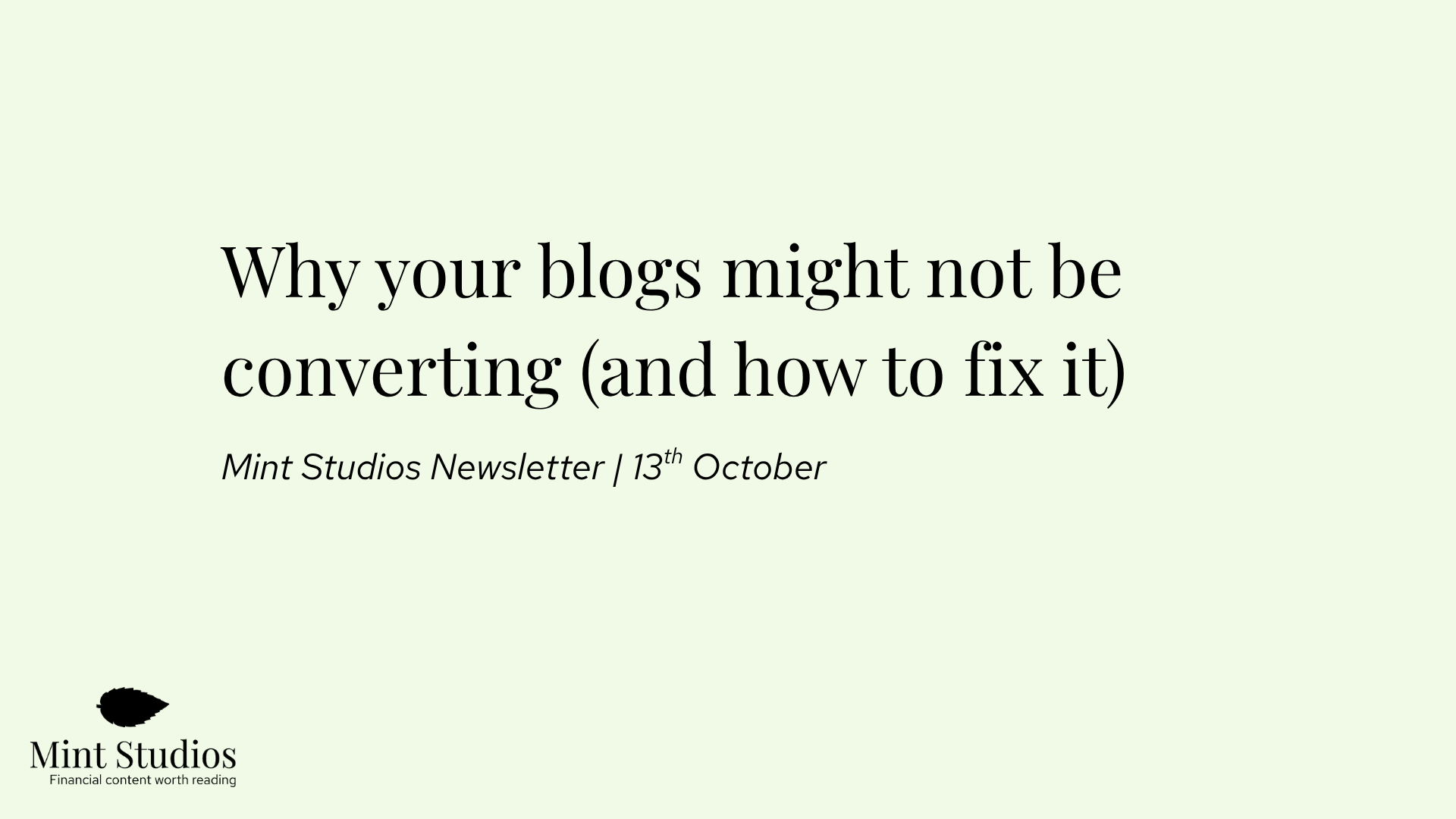Most of the articles that talk about inbound for fintech companies will talk to you about the benefits of inbound marketing, and why it’s so important for the fintech industry.
But the truth is, you probably already know why inbound is important, and are instead looking for a strategy to help implement inbound marketing in your fintech business.
In this article, we’ll focus on a very specific inbound marketing strategy that will help bring leads and new customers to your fintech company — while also building your brand, and helping you pursue your mission of financially educating your readers.
This specific digital marketing strategy is usually called content marketing, but not content marketing as you might know it. It’s content marketing that is highly focused on conversions and expert content.
At Mint Studios, we’ve helped 20+ fintech startups and scaleups acquire customers — not just traffic — with this inbound approach.
We’ll talk about:
- The main issues with content marketing and inbound
- How to create content that drives inbound customers
- How to track your customers coming inbound
The issues with most content marketing efforts
Content marketing via SEO is one of the most powerful ways of implementing inbound fintech marketing. But we’ve seen many issues with how people implement it:
A lot of content isn’t written for the right target audience
If you work in the B2B space, then you’ll know how important it is to create content for your target market.
Especially if your product is complex and in financial services, writing an article on “types of payment methods” will not resonate if you’re targeting payment experts. But if you head to the blog of many B2B companies with more complex topics, you’ll often see articles with beginner level content. Here’s a screenshot of a B2B financial technology company that targets CFOs:

No matter what your inbound fintech marketing strategy is, if your content is not written for the right audience, your prospects are less likely to be interested in reading the rest of your content or even learning about your product.
The main reason companies produce beginner style articles is because a lot of content is written by generalist freelance writers. Freelancer writers are a great resource at the testing stage of your marketing journey, but if you want inbound marketing to work, there are issues that come with working freelance writers:
- They don’t know about your product
- They don’t know about your topic
- It could end up being regurgitated Google research
You can read more about this in depth here: Why We Believe Hiring Freelance Writers Doesn't Work for Most Companies
Most content isn’t focused on acquiring customers
If you read most fintech blogs, you’ll see that most of it is “Top of the Funnel”, meaning it focuses on educational topics — often not even related to the product.
And that’s fine — but the problem is you won’t get many inbound leads with this method. Sure, you’ll bring in organic traffic, but it’s unlikely to bring in real customers. That’s because an increase in traffic does not always equal an increase in conversions and lead generation.
A lot of fintech brands focus on creating content that increases their website traffic and then posting on social media — but then you often end up targeting people who aren’t even aware they have a problem and that your product offers a solution.
That’s why we argue that it makes more sense to target the Bottom of the Funnel first: people who are aware of their issue, aware of the solution and already seeking out and comparing options. We’ll explain how to create content focused on conversions below.
Most marketing teams are not tracking content attribution
In order to track the return on your investment in inbound, you need to be tracking the results of your content efforts.
Some people believe that content cannot be tracked. They believe that content is purely for brand awareness, and so there is no point in tracking leads — or that attribution is impossible.
Content attribution not a perfect science, but we believe it makes sense to track as much as you can. And the truth is that yes, you can track attribution to content. We’ll go into detail on how to do this below.

If you can prove that you’re acquiring customers with content, then you it’s easier to ask for more investment and resources spent on content.
How to create content that drives inbound customers
In order to attract potential customers instead of chasing them — the art of inbound — you first need to know what they are searching for online.
Here’s a step by step guide to creating content for inbound digital marketing.
1. Create a content strategy that includes bottom of the funnel and focuses on pain points
Instead of only creating Top of the Funnel content, consider a content strategy that focuses on Bottom of the Funnel content. Bottom of the Funnel (BOFU) content means content that targets people who are ready to buy: they know they have a problem, they know what the solution is and are actively looking for it.
Why? We argue that these are your best customers. These are people who are ready to buy and are low hanging fruit. If your product does not turn up when they are ready to buy, you are essentially leaving customers on the table.
We categorise Bottom of the Funnel content in three ways:
- Use cases for your product
- Pain points
- Classic BOFU keywords: “alternatives to…”, etc
By creating content that focuses on these three types of BOFU content, it’s also a lot easier to prioritise: start with the content where the pain points are greatest.
How do figure out your customer’s pain points? We’ve created an article breaking down how we do research here: How to Do Research for Bottom of the Funnel Content Marketing
In essence, you want to set up calls with the sales team, product team and the most customer facing team, and try to understand why customers use your product and what the pain points are. That’s how you know what drives a customer to start doing research.
In the case of Parpera, one of our clients, we knew some of the pain points of freelancers were that they wanted to make sure the invoices they created were compliant and wanted to make sure they made sense. This is one of the first articles we created:
For another of our clients, Jeeves, we knew that one of the pain points was that Amex was very expensive. So one of the first articles we wrote targeted the keyphrase “Amex no annual fee”. Here’s the article:
2. Implement Pain Point SEO
You might be creating content that focuses on Bottom of the Funnel and targeting the right readers — but how do you get the content in front of them?
By targeting the right keywords on Google and using Search Engine Optimisation to rank the highest.
This approach does use SEO, but it’s not your typical SEO. Meaning, it doesn’t involve doing the typical exercise of: putting together a huge spreadsheet of keywords, prioritising by highest volume and then creating general articles stuffed with keywords.
Instead, this approach uses pain point SEO. Once you understand your customers’ pain points and the main uses cases for your product, only then do you find the keywords to match those. There are a few keywords that we call “classic BOFU”, and usually indicate someone is ready to buy:
- Alternatives to. (e.g. alternative to Paypal)
- Comparison articles (e.g. Xero vs Freeagent)
- Best of articles (e.g. best accounting software for freelancers)
- Pricing pages (e.g. how many fees do [incumbent competitor] charge?)
- Use case blogs (e.g. how do I open a bank account as a contractor?)
By creating content that focuses on pain points and Bottom of the Funnel keywords, your content and product is turning up in the right places when your customers are doing research. And that’s key to a successful inbound marketing strategy.
These are a few examples of classic BOFU content we’ve written for clients:
3. Articles and content that are created for the right audience
But getting in front of the right people is just half the battle — you still need to create high quality content that also translates into leads and customers.
That means creating high quality content that genuinely speaks to the reader. It also means creating content that talks about your features and products in-depth.
Unfortunately, it’s a lot easier said than done. You can’t rely on a generalist writer to create an in-depth article on how your spend management solution works for split payments (something that can’t be Googled). And sure, you can hire a fantastic specialist writer instead — but these are often incredibly expensive (rightly so). So what’s the solution?
Combine the two: work with a writer who can create content that is based on interviews with experts. People are usually either great experts, or great writers. By asking your writers to create content based on an interview with an expert, you can get the best of both worlds.
The benefits are:
- Your content is based on expertise, and not just Google research
- Your content can include important details about the product (which BOFU readers will want to know)
- You come across as an expert, and are therefore respected in your field
- It’s easier to sell your product and position it correctly so the reader reaches out.
Here are some example of articles we’ve written based on expert interviews. Notice how we include technical details about a product, which we wouldn’t be able to do without an interview:
- Apply for a Sole Trader ABN Online (In Under 10 Minutes)
- Split payments API: How Zai's API can help you set up a custom payment workflow
Tracking your inbound marketing results
Once you’ve identified your customers’ pain points and are creating content that focuses on their pain points and is written for the level of the audience, how do you track it and make sure inbound marketing is working?
First of all, we like to think of our first 3 - 6 articles as hypotheses. There is a lot of testing that goes on in content marketing as you’re trying to figure out how to rank on Google, what messaging seems to resonate and what converts readers into customers.
If your articles are easy to read, targeting a BOFU keyword and written at the level of your personas, the next step is to do the tracking and measure performance.
You can do this through Google Analytics, Google Tag Manager, Hubspot or whatever product tool you use. But make sure it can be attributed to specific articles.
Here’s a guide we put together on how to track conversions via Google Analytics: How to Calculate How Many Customers You're Getting with Content
Every so often, you’ll be able to see how your pieces of content are doing over time. If it’s working well and you are experimenting and testing, then you should see results.
A few caveats:
Your website is very new website
Since we’re using SEO, you’ll be competing against other websites to rank high. If your website is brand new and has a low number of backlinks, it could take up to a year to see results. Be prepared to wait a while.
You’re in a very competitive landscape
If you are in a very competitive industry, then it could also be hard. We have seen good results even in competitive industries, but it’s important to focus even more on specific pain points and rely on customer research and the customer journey, rather than keyword research.
To round up: content marketing is a powerful way to set up inbound marketing as a fintech company
Inbound marketing with content marketing is a powerful way to acquire customers. Once you invest in it, the returns compound often exponentially over time. Not just that, but as a fintech company, content can help you push your mission to promote financial education and literacy.
If you’re interested in learning more about this methodology, and want to see if it could be an approach that would work for you, set up a 30 minute free consultation with our Director of Content at our fintech marketing agency Mint Studios, to see if this approach makes sense for your company:











